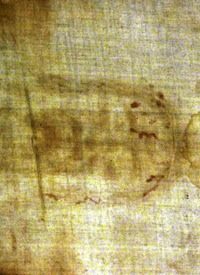
The ongoing controversy over the Shroud of Turin has taken an interesting new turn, with a researcher claiming to have found text concealed in the shroud that would place its origins in the first century A.D.
The shroud — which is kept in the Cathedral of St. John the Baptist in Turin, Italy — bears the image of the body of a man that appears to show wounds consistent with crucifixion, which proponents of the shroud’s authenticity maintain is the image of the crucified Christ. A controversy has raged over the origin of the image — whether it is the result of some man-made process, presumably being crafted early in the 14th century, or whether the nature of the shroud’s origin must, in the assessment of investigators, remain mysterious, even miraculous.
According to an Associated Press report (“Researcher says text proves Shroud of Turin real”), the presence of first-century text on the shroud upholds the authenticity of the shroud:
A Vatican researcher claims a nearly invisible text on the Shroud of Turin proves the authenticity of the artifact revered as Jesus' burial cloth.
The claim made in a new book by historian Barbara Frale drew immediate skepticism from some scientists, who maintain the shroud is a medieval forgery.
Frale, a researcher at the Vatican archives, said Friday that she used computers to enhance images of faintly written words in Greek, Latin and Aramaic scattered across the shroud.
She asserts the words include the name "Jesus Nazarene" in Greek, proving the text could not be of medieval origin because no Christian at the time, even a forger, would have labeled Jesus a Nazarene without referring to his divinity.
Those who have maintained that the shroud is an elaborate forgery frequently cite the fact that when it was subjected to radiocarbon dating in 1988, the results of the test produced a date between 1260 and 1390 A.D. Although the results of the 1988 test were widely accepted, still they have been criticized on scientific grounds, citing, among other factors, the exposure of the shroud to two fires during the time period in question, which arguably could have contaminated the shroud.
Frale’s claims drive the debate in a different direction, contending that a study of the text that she purports may be found on the shroud offers confirmation of its first-century origins. According to the AP:
Frale claimed the text also partially confirms the Gospels' account of Jesus' final moments. A fragment in Greek that can be read as "removed at the ninth hour" may refer to Christ's time of death reported in the holy texts, she said.
On an enhanced image studied by Frale, at least seven words can be seen, fragmented and scattered on and around Jesus' face, crisscrossing the cloth vertically and horizontally. One short sequence of Aramaic letters has not been translated. Another Latin fragment — "iber" — may refer to Emperor Tiberius, who reigned at the time of Jesus' crucifixion, Frale said.
"I tried to be objective and leave religious issue aside," Frale told The AP. "What I studied was an ancient document that certifies the execution of a man, in a specific time and place."
Despite Frale’s claims, critics remain unconvinced, and some have been quick to respond to the purported new evidence.
"People work on grainy photos and think they see things," said Antonio Lombatti, a church historian who has written books about the shroud. "It's all the result of imagination and computer software."
Lombatti said that artifacts bearing Greek and Aramaic texts were found in Jewish burials from the first century, but the use of Latin is unheard of.
For those who believe in its authenticity, the shroud is seen as evidence which may one day overturn the secularist mindset which has taken hold in the West. In the words of Russell Kirk, one of the "fathers" of 20th-century American conservatism:
The Shroud, if indeed it is a [sic] artifact of the time of the death of Jesus, is a confirmation of the Synoptic Gospels and indeed of the whole Christian story; but particularly of the life and death of Jesus of Nazareth. Also there may be something more than that. If it is produced by a miraculous means — that is, using the word "miraculous" to mean an occurrence or process which is something beyond the ordinary operation of what we used to call the laws of nature, an exceptional, most extraordinary event — if indeed the image on the Shroud is the product of a miracle, then Christian dogmas seem to be confirmed; and we may return to the Ages of Faith.
The Roman Catholic Church has not officially taken a position on the authenticity of the shroud. Pope Benedict XVI is scheduled to visit the shroud on May 2, 2010.
Related article:



